|
The
bridgegead at Uckange - Operation Casanova
| Date
: From 8 To 14 November 1944 |
| Location
of the action : Uckange, France |
| Unit
in the area : 1st Battalion, 377th Inf. Reg. |
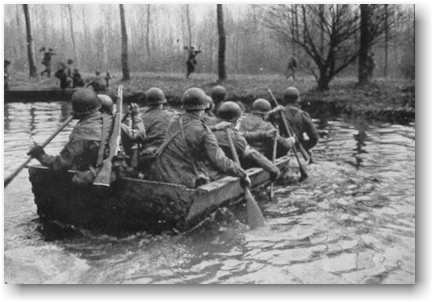
Above :
First's
crossing at Uckange was made in boats like this one; it's
a training shot of the 377th Infantry Regiment making
assault crossing.
A la
mi-Novembre 1944, le projet de réaliser un véritable
franchissement à Thionville était planifié, mais il
fallait persuader les Allemands que le franchissement
aurait lieu au Sud de Thionville. Le besoin de créer une
autre tête de pont faisant "diversion", était
demandée. L'unité désignée pour cette mission nommée
"Opération Casanova" était le 1st Battalion du
377th Infantry Regiment tandis que les deux autres unités
de la Division, le 378th et le 379th Infantry Regiment,
contiennent le saillant fortifié occidental autour de
Metz. Le rapport de la mission spécifie que l'attaque
sera menée le 8 Novembre, soit un jour avant que le XXth
Corps ne se mette en route. Ainsi, le premier sang versé
dans la bataille finale de Metz sera versé par les
"nouveaux gars" de la 95th Infantry Division.
The
1st Battalion was chosen to make the river crossing, and
after the move from the southern bridgegead, they were
transferred to the riverbank in the Uckange area. All 95th
Division markings were removed, fake message traffic was
maintained and they disguised themselves as the 359th
Infantry Regiment, by then on the north toward Aumetz.
Their mission was to cross the Moselle, move across the
flood plain on the far side and occupy the small town of
Immeldange astride the main north-south road between Metz
and Sierck-lès-Bains. There they were to dig in and wait
to be relieved by troops moving down from the main
crossing site.
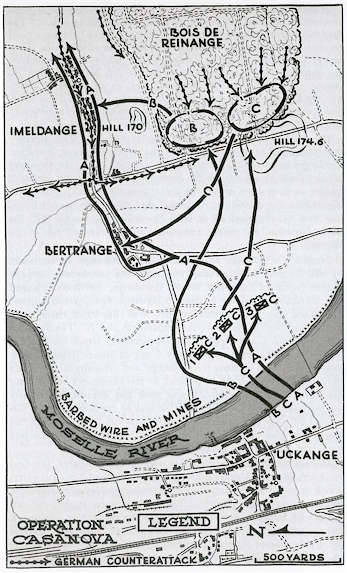 |
|
Above :
Map
of the operation Casanova
(from
8 to 14 November 1944). |
The
appalling weather conditions precluded the planned
preliminary air attack on the enemy on the far bank, but
an artillery concentration was fired. At dusk, a company
of the 320th Combat Engineer Battalion slipped across the
river, detonated mines, and blew a gap through the barbed
wire. At 2100, Company C of the 377th Infantry
Regiment paddled across in 17 assault boats, a distance of
some 200 yards. Once over they met with no immediate
opposition as the German were entrenched further back
along the line of the main road, and the 73rd Regiment of
the 19 VG Division required some time to react. This is
surprising because the activities of the engineers must
have made a tremendous racket.
The
small group of infantry advanced some 400 yards across the
featureless floddplain and then dug in to await daylight.
It was then that enemy artillery homed in on them, as they
were well within range of the concentration of guns that
had been amassed to counter the earlier attacks on Maizières-lès-Metz.
However, most of the shells fell behind Company C, on the
crossing site where the engineers were frantically trying
to construct a footbridge. On account of the shelling,
this had to be abandoned, and Company A was ferried over
in the early hours of 9 November. By then, however, the
weather had begun to exert its baneful influence. During
the previous night the river had started to flood, fed by
the torrential rain, and by the morning had burst its
banks. The turbulent waters had spread out over the flood
plain, doubling the normal width of the river and vastly
increasing the speed of the current. The approach road to
the crossing site disappeared under the water and all
efforts to get a telephone line across were frustrated by
the current. Thus the only means of communication were via
a frail radio link.
By daybreak on 9 November, the 1st Battalion had two rifle
companies and a heavy weapons platoon across the swirling
river. They then began to move off further inland,
bypassed the village of Bertrange and established
themselves on a low hill to the east, out of reach of the
spreading water. Although not directly menaced by enemy
infantry, shelling and mortar fire were heavy and the men
dug in to keep warm. At 0905, the batallion reported hack
to Regimental HQ : "Two companies are across river.
River is very high and we're not sending others over".
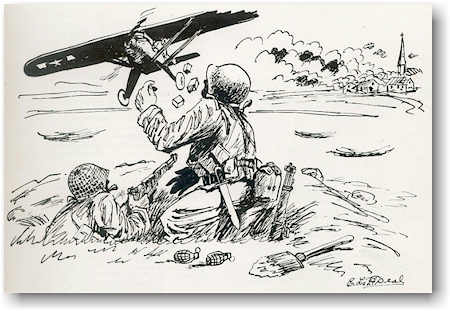 |
|
Above :
Sketched
by PFC Ernest. L. Deal
of Company A, we can see the dropping of rations and
small arms ammunition from artillery liaison planes. |
The flood
waters frustrated all attempts to supply the two companies,
who were by then entirely cut off. The speed of the
current and accurate enemy shelling made daylight movement
across the Moselle more or less impossible, even when
outboard motors were attached to the assault boats. It was
therefore decided to try air supply by artillery spotter
aircraft. Ten L-4's flew throughout the afternoon, each
with a "dropper" who had volunteered to squat
behind the pilot. Flying at only 25 feet, they managed to
deliver 1080 K-rations, 46000 rounds of small-arms
ammunition, 4000 rounds of 50-caliber ammunition, medical
supplies, cigarettes, water purification tablets, plasma,
and even a sack of toilet paper. The drops were certainly
accurate, and a platton leader said: "We got all the
rations we needed from the planes." Major Neumann,
who flew several missions, reported that he "coukd
seee some of our men standing in water in their foxholes.
They waved and shouted when we dropped some rations right
down next to the foxhole." This was the first of
several occasions during the Battle of Metz when such
light aircraft were used for resupply missions to isolated
troops.
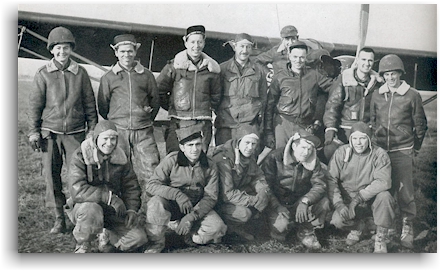 |
These
exceptional photographs show the men incorporated in
the artillery
liaison planes of the
Division.
Among them, some men did a great job during the
bridgehead of Uckange and delivered ammunition,
rations and medical supplies by air. On
the left :
Pilots
et observers in front of a L-4.
Below :
Ground
crew : mechanics, radiomen, first aid men, cooks. |
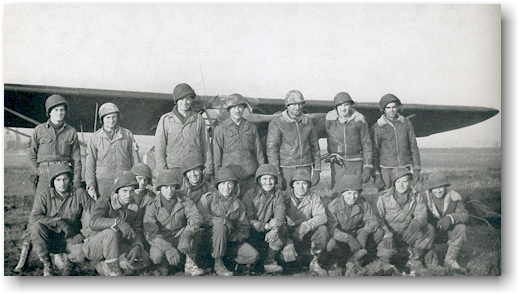 |
An
indication that gentlemanly conduct could still prevail
was provided when a boatload of medical personnel,
displaying the Red Cross, tried to get over the River.
Dragged away by the current, they were met on the far bank
by two German soldiers, who emerged from a dugout. In good
English the medics were told that they were in the wrong
place and were directed further downstream. Somewhat
puzzled and suspicious, they managed to return to their
starting point where they were redirected by the battalion
commander. Setting off for another attemps, they crossed
the river and paddled on across the flood plain until they
arrived at the outskirts of Bertrange. There, a German
officer appeared and told them :
"No American troops here. We are taking care of one
wounded American. Your troops? Up there." He then
redirected them to where the American were dug in.
On
10 November, in spite of the danger from icing on the
wings, further supply missions were flown. There was worry
about dropping mortar rounds as it was feared that they
would go off on inpact. As an experiment, an aircraft flew
over German-held Bertrange and dropped several rounds on
the human guinea pigs below. Not observing any explosions,
the pilots assumed that it was safe to drop the rounds on
their own men.
During the night of 11 and 12 November, the flood waters
began to recede, and the following night it proved
possible to ferry across the remainder of the battalion.
This was undertaken without loss, as the engineers carried
out a feint crossing by running their outboard motors, to
distract the German artillery observers.
The
operation of the Uckange bridgehead failed to tie down any
significant numbers of German reserves. The main attack
which started on the following day was immediatly
recognized to be the more important thrust. Thus the point
of the deception was lost. The 19 Volksgrenadier
Division did not have any reserves to commit anyway and
would soon have realized that only small numbers of
Americans were involved. By then, the German had
identified the 10th Armored Division north of Thionville
and had observed the buildup of bridging equipment in this
area.
During this time, the
2nd Battalion of the 378th Infantry Division commanded by
Colonel Maroun, did a real bridgehead in Thionville,
received the order to gather the Battalion plus some tanks
and tank destroyers, and attack southward to relieve the
defenders in the Uckange bridgehead.
During
the morning of 13 November, 1st Battalion was ordered by
the 95th Infantry
Division to move off to the north, bypass Bertrange and Immeldange
and capture Illange where they would link up with Colonel
Maroun's men. The mens of this battalion took the two
former town without difficulties, but as they regroupped
prior to moving off, they were struck by a task force from
the 73rg Grenadier Regiment, supported by some antitank
guns. The forces in the two towns became separated and
went to ground as the Germans roared up and down the long
main streets in armored personnel carriers shooting at
anything that moved. Communication with their artillery on
the west bank broke down.
It was only restored early in the morning of 14 november,
with a First Sergeant of the Company A acting as forward
observer. However, in spite of the usually effective
American artillery response, the Germans were not easily
discouraged. They pressed their attacks all day, supported
by light armored vehicles, to such an extent that at 2200,
the battalion commander reported that his mission was "desperate".
One must remember that the 1st Battalion men were armed
only with the weapons that they could carry and had been
in action nonstop since the evening of 8 November.
During the evening, communications again broke down, and
on the morning of 15 November, the remainder of the
battalion was still holding out in the gutted ruins of the
two villages. Bacon's force arrived just in the nick of
time, but during his advance, and using his tank
destroyers as self-propelled artillery, Colonel Bacon
shelled the Germans out of Bertrange and Immeldande, and
by 1300, the beleaguered forces were relieved. Their
strength, however, had been reduced to a mere handful of
officers and men, but instead of being sent into reserve,
they immediatly became a part of Task Force Bacon.
At
2345, November 15, Colonel Bacon, reported the following
strength figures for the rifle comanies of the 1st Battalion.
(It will be remebered that the
normal strength of a rifle company is over 180 men.)
Company
A : 1 officer and 42 enlisted men
Company
B : 1 officer and 39 enlisted men
Company
C : 4 officers and 107 enlisted men.
The figures speak for themselves on the price the 1st
Battalion had paid for Operation Casanova. The results
were less tangible, but it is clear that the 1st
batallion had made a contribution to the overall success
of the Metz operation. They had drawn a large percentage
of German artillery fire to Uckange area, and thus made
easier the crossing of the 90th Infantry Division at Koenigsmacker
and of the 2nd Battalion of the 378th Infantry
Regiment at Thionville. In addition, they had forced the
Germans to expend armor and infantry in a futile attempt
to wipe out the Uckange bridgehead. They had held their
ground against this counterattack and on November 16 they
pushed aggressively south with Task Force Bacon and were
to play an important part in the final assault on Metz.
|

